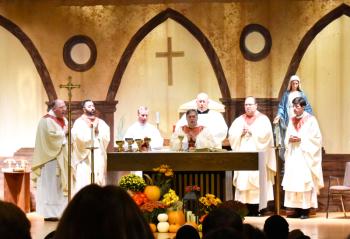By PAUL WIRTH Diocesan Communications Staff
A report sent recently to the Vatican provides a snapshot of changes in the Diocese of Allentown over the past eight years.
The Diocese now has fewer priests, fewer parishes and fewer schools than it did in January 2011, and the number of baptisms, first holy communions, confirmations, and Catholic marriages has declined. These trends are similar to those in many dioceses around the country.
While the statistics are indicators of major challenges, the report also outlines some important bright spots in the life of the Diocese of Allentown over the same eight-year period:
- Young men continue to hear Christ’s call to the Priesthood and enter the seminary. “These seminarians have a pastoral zeal which offers great hope for the future,” the report says.
- The number of Spanish-speaking Catholics continues to increase, and now stands at 25 percent of parishioners in the Diocese.
- A new high school for students recovering from addiction, Kolbe Academy, opened this year.
- More than 2,000 adults converted to Catholicism and joined the Church through the Rite of Christian Initiation of Adults.
- The clergy have found renewed strength and growth in their lives of service to the Church. The mutual love and respect between the faithful and their priests and deacons is “an essential element of the good work that is occurring the Diocese,” the report says.
- Donations by the faithful, in the form of weekly collections and Mass and charitable contributions to Because We Are Catholic, the Bishop’s Annual Appeal, have remained relatively steady.
The report recognizes the heartfelt concern among the faithful when a parish is consolidated or closed, and when a school is merged or closed. The process of evaluating parishes and schools for long-term viability began as the result of the Second Diocesan Synod in 2005 and 2006, and has continued.
The Catholic population of the Diocese is made up primarily of descendants of European immigrants who arrived in the late 1800s and early 1900s, the report notes. Today, however, the fastest-growing ethnic group in the Diocese is people of Hispanic descent, who have arrived in the past twenty or thirty years from Mexico, Central and South America, and the Caribbean.
The Diocese has taken steps to welcome Spanish-speaking people, the report says. Spanish-language Masses are offered at ten parishes, the Diocese has an Office of Hispanic Affairs, and Bishop Alfred Schlert has been studying Spanish so that he can better celebrate Mass and other sacraments in Spanish.
The greatest challenge in recent history is the clergy sexual abuse crisis, the report acknowledges. The Diocese has continued to strengthen its programs and procedures to keep children safe while responding immediately to credible allegations by notifying law enforcement, by removing the priest from ministry, and by being transparent in cooperation with law enforcement.
As part of its response, the Diocese established a new senior-level position, Secretary for Youth Protection, and also began an Independent Reconciliation and Compensation Program to compensate victims of clergy sexual abuse as one aspect of their healing.
The Lord has bestowed many blessings upon the Diocese of Allentown during the past eight years, the report concludes, in the midst of the challenges of the clergy sexual abuse crisis and the rise in the United States of those who do not practice any faith.
Looking ahead, the report sets out several main goals for the Diocese in coming years: continued healing in the Church, increased Mass attendance, evangelization and religious instruction of the faithful, and encouraging more men to become priests.








